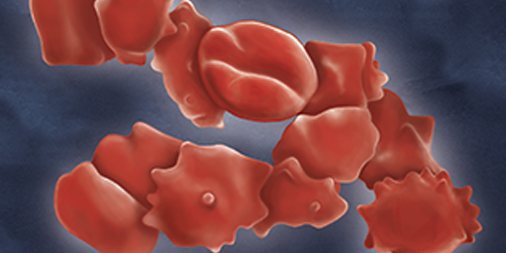Red Blood Cells and Mercury
Posted on by Dr. Francis Collins

Credit: Courtney Fleming, Birnur Akkaya, and Umut Gurkan, Case Western Reserve University, Cleveland
Mercury is a naturally occurring heavy metal and a well-recognized environmental toxin. When absorbed into the bloodstream at elevated levels, mercury is also extremely harmful to people, causing a range of problems including cognitive impairments, skin rashes, and kidney problems [1].
In this illustration, it’s possible to see in red blood cells the effects of mercury chloride, a toxic chemical compound now sometimes used as a laboratory reagent. Normally, healthy red blood cells have a distinct, doughnut-like shape that helps them squeeze through the tiniest of blood vessels. But these cells are terribly disfigured, with unusual spiky projections, after 24 hours of exposure to low levels of a mercury chloride in solution.
The lab of NIH-grantee Umut Gurkan at Case Western Reserve University, Cleveland, has extensively characterized red blood cells following their exposure to mercury. In this image, Gurkan and colleagues first captured those changes in black and white using scanning electron microscopy (SEM). Courtney Fleming, a biomedical art student at the Cleveland Institute of Art and an intern in the Gurkan lab, then adapted those SEM micrographs into this colorful scientific illustration showing how the misshapen red cells might look coursing through a person’s veins and arteries. For their creative efforts, the team was selected as one of the winners in the Federation of American Societies for Experimental Biology’s 2017 BioArt competition.
Gurkan’s interest in red blood cells began with studies in patients with sickle cell disease. His studies later expanded to include many conditions in which the form and function of red blood cells may be affected. They’ve seen that mercury-exposed red blood cells don’t just look different. They also become stickier. They have evidence that the stickiness makes them more likely to adhere to blood vessels, which may impede blood flow especially in the tiniest capillaries. That also happens in sickle cell disease.
Most tests used to examine blood cells today only capture changes in blood cell counts. But Gurkan’s team is now developing a microfluidic device designed to characterize other important properties of red blood cells and their interactions with blood vessels [2]. The hope is that such a tool will ultimately improve our understanding of the role that changes in red cells might play—not just in the case of mercury exposure, but in many other health conditions, including sickle cell disease, cardiovascular disease, diabetes, and neurological disorders.
References:
[1] Mercury Factsheet, Centers for Disease Control and Prevention, April 7, 2017.
[2] Sickle cell disease biochip: a functional red blood cell adhesion assay for monitoring sickle cell disease. Alapan Y, Kim C, Adhikari A, Gray KE, Gurkan-Cavusoglu E, Little JA, Gurkan UA. Transl Res. 2016 Jul;173:74-91.e8.
Links:
Mercury (National Institute of Environmental Health Sciences/NIH)
Umut Gurkan (Case Western Reserve University, Cleveland, OH)
BioArt (Federation of American Societies for Experimental Biology, Bethesda, MD)
NIH Support: National Heart, Lung, and Blood Institute
Share this:
- Click to share on LinkedIn (Opens in new window)
- Click to share on Pinterest (Opens in new window)
- Click to share on Tumblr (Opens in new window)
- Click to share on Reddit (Opens in new window)
- Click to share on Telegram (Opens in new window)
- Click to share on WhatsApp (Opens in new window)
- Click to print (Opens in new window)

Thank you for this. I developed mercury poisoning and escalating neurological problems from decades-long exposure to mercury off-gassing from dental amalgam fillings, which is rarely considered but a common problem for people with genetic variants in methylation pathways. If you do not excrete mercury well, it bioaccumulates. I recovered my health by working with a biological dentist for safe removal and replacement with biocompatible materials. When will FDA address the concerns of its own expert panels and warn patients of health risks, or better, ban dental amalgam as several Scandinavian countries, and Japan have done? The EU voted to end its use in children under 15 and in pregnant and nursing women as of July 1st. We are waiting.
Putting mercury in our mouths is toxic, and all ‘system’ people know it. I can only imagine that our bodies are used as manufacturing plants, turning mercury to gold…simply by knocking off one s electron. After putting mercury in our mouths for decades, the psychotics calling themselves scientists must have noticed that the mercury, 2″ from our brains, damaging massive numbers of brain cells, combined with copper in our CNSs, and removed it from the body. Enter Strontium 93 and Barium in coal slurry, sprayed on us every day, and the copper spaces were occupied by that molecule. But some of the mercury becomes gold, says a “family” member, and wouldn’t that be the reason the corporate city workers have people collecting sewage from our homes?